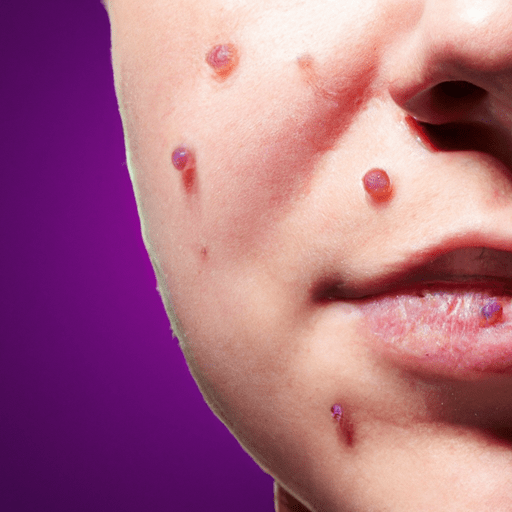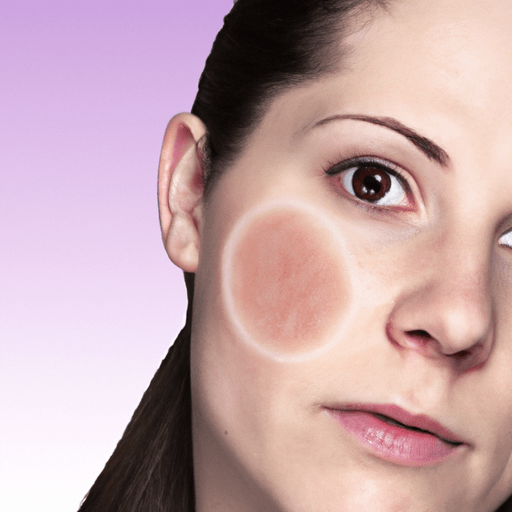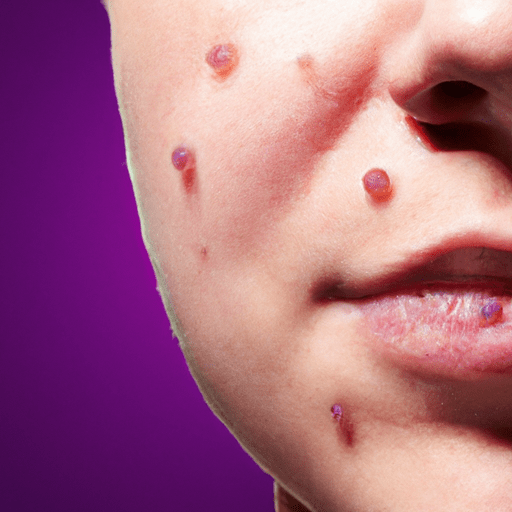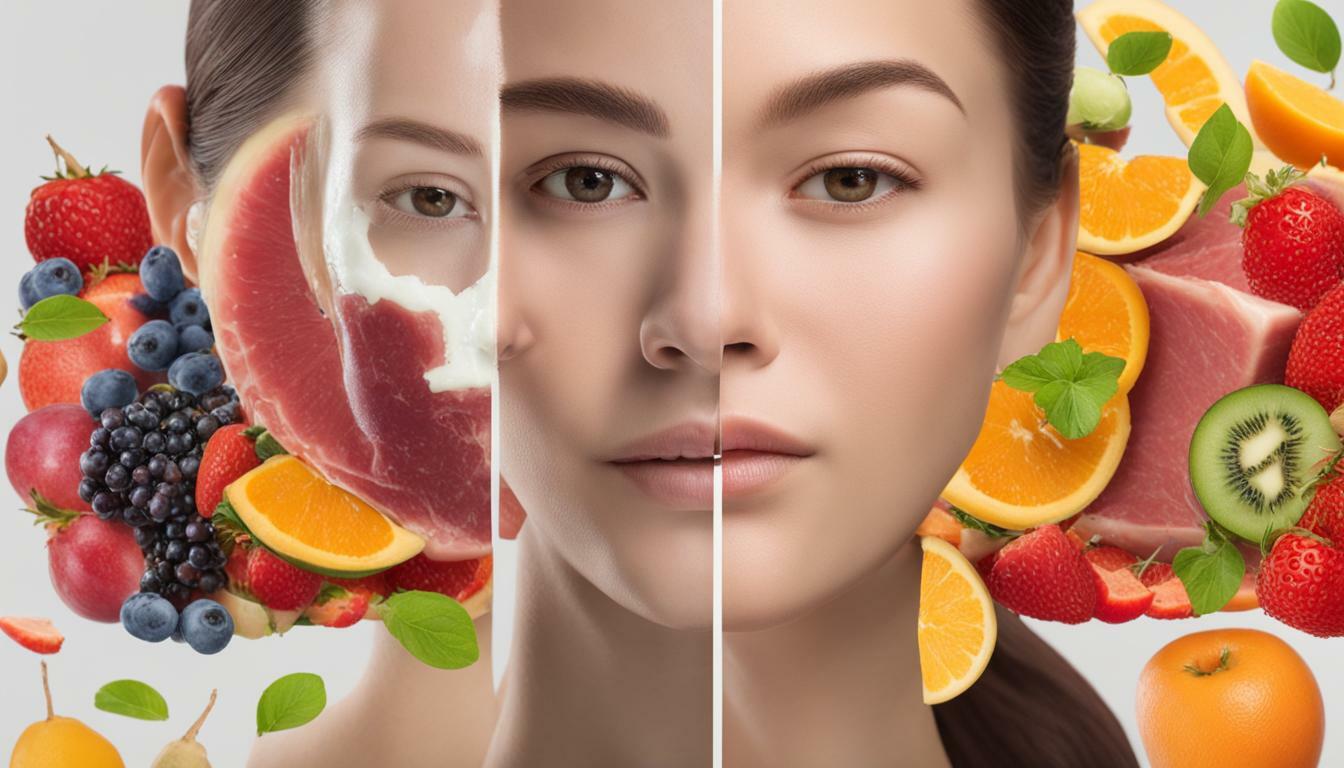Have you ever wondered why your acne sometimes appears purple? It may seem odd, but there’s actually a scientific explanation behind it. In this article, we’re going to explore the reasons why acne can take on a purple hue and what it means for your skin. Understanding the causes of purple acne can help you better manage and treat your breakouts, so let’s dive right in.
Understanding Acne
Acne is a common skin condition that affects many people, especially during their teenage years. It is characterized by the presence of pimples, blackheads, whiteheads, and other types of lesions on the skin. While acne is often associated with the facial area, it can occur on other parts of the body as well, such as the chest, back, and shoulders.
Definition of Acne
Acne is a chronic inflammatory skin condition that occurs when hair follicles become clogged with oil, dead skin cells, and bacteria. It typically presents as red bumps or pus-filled pimples and can be painful or tender to the touch. Although it is more common during puberty, acne can affect people of all ages.
Causes of Acne
The exact cause of acne is still not fully understood, but several factors contribute to its development. Excessive oil production, irregular shedding of dead skin cells, hormonal changes (especially during puberty), and the presence of bacteria on the skin are all known to play a role in the formation of acne. Additionally, certain factors such as stress, diet, and genetics can also influence the severity and frequency of acne breakouts.
Types of Acne
Acne can manifest in various forms, each with its own distinct characteristics. The most common types of acne include:
1. Whiteheads: Closed comedones that appear as small white or flesh-colored bumps on the skin’s surface.
2. Blackheads: Open comedones that are black or dark in color due to oxidation of the trapped debris within the hair follicle.
3. Papules: Small, red, tender bumps that are typically inflamed and can be sensitive to touch.
4. Pustules: Similar to papules, but with a visible pus-filled center.
5. Nodules: Large, solid, painful lumps beneath the skin’s surface. These can be particularly stubborn and may cause scarring.
6. Cysts: Deep, pus-filled lesions that are often painful and can result in significant scarring if not treated promptly.
Understanding the specific type of acne you have is crucial for determining the most effective treatment approach. If you are unsure about the type of acne you have or are experiencing severe symptoms, it is advisable to consult a dermatologist for a proper diagnosis and treatment plan.
The Role of Inflammation in Acne
Inflammation is a central process in the development and progression of acne. When the hair follicles become clogged, immune cells rush to the site to fight off the bacteria and remove the debris. This immune response triggers an inflammatory reaction, leading to the characteristic redness and swelling associated with acne lesions.
Inflammation in Acne
The inflammation in acne is mainly caused by the immune system’s response to the presence of bacteria and the release of certain chemicals, such as cytokines and chemokines, that promote inflammation. As the immune cells attempt to eliminate the bacteria, they inadvertently cause damage to surrounding tissue, leading to the formation of red, swollen pimples.
How Inflammation Affects Acne
The inflammation in acne not only contributes to the formation of pimples but also influences their progression and severity. Pimples that are inflamed tend to be more painful and take longer to heal compared to non-inflamed lesions. Additionally, inflammation can lead to the expansion of blood vessels in the affected area, further contributing to redness and discoloration.
Why Acne Lesions May Appear Red or Purple
The red or purple hue of acne lesions is primarily due to the inflammatory response and increased blood flow to the area. As the immune cells rush to combat the bacteria and debris, they cause dilation of blood vessels, resulting in the skin looking red. In some cases, the inflammation can be severe enough to cause damage to the blood vessels themselves, leading to the appearance of purple discoloration in the affected area.

Hyperpigmentation and Acne
Hyperpigmentation is a common skin concern that often accompanies acne breakouts. It refers to the darkening of certain areas of the skin, where an excess of melanin, the pigment responsible for skin and hair color, is produced.
What is Hyperpigmentation?
Hyperpigmentation occurs when there is an overproduction of melanin in certain areas of the skin. This can result from various factors like sun exposure, hormonal changes, inflammation, and injury to the skin. Hyperpigmentation can present as small patches, spots, or large areas of darkened skin.
Mechanism of Hyperpigmentation in Acne
Hyperpigmentation in acne occurs as a response to the inflammation and trauma caused by acne lesions. When the skin experiences inflammation, the production of melanocytes, the cells responsible for producing melanin, is stimulated. This increased production of melanin leads to the darkening of the skin, resulting in the development of hyperpigmented spots or patches.
The Relationship Between Hyperpigmentation and Acne
Hyperpigmentation often occurs after an acne lesion has healed. Once the inflammation subsides, the skin starts producing excess melanin in response to the previous trauma, leaving behind darker spots or patches. This hyperpigmentation can vary in intensity and may take weeks or months to fade on its own, depending on the individual’s skin type and healing process.
Why Hyperpigmentation May Appear Purple
In some cases, hyperpigmentation associated with acne may take on a purple hue. This can occur when the excess melanin production combines with the underlying inflammation, causing a deeper, more intense pigmentation. The purple coloration is a result of the interaction between the melanin and the blood vessels in the affected area, creating a unique visual appearance.
Post-inflammatory Hyperpigmentation (PIH)
Post-inflammatory hyperpigmentation (PIH) is a specific type of hyperpigmentation that follows an inflammatory skin condition like acne. It refers to the dark spots or patches that persist after an acne pimple has healed.
Understanding PIH
PIH occurs due to the overproduction of melanin by melanocytes in response to the inflammation and trauma caused by acne lesions. It typically appears as flat, dark spots that can range in color from light brown to dark brown or even black.
Causes of PIH
The main cause of PIH is the excessive production of melanin triggered by inflammation. However, certain factors can increase the likelihood of developing PIH, such as picking or squeezing acne lesions, exposing the skin to sunlight without adequate protection, and certain genetic predispositions.
How PIH Relates to Acne
PIH is closely related to acne, as it often occurs as a result of the healing process of acne lesions. Although PIH does not cause active acne breakouts, the presence of these dark spots can still have a significant impact on an individual’s self-esteem and overall satisfaction with their skin.
Why PIH May Manifest as Purple Spots
Purple spots can be a variant of PIH and occur when there is a higher concentration of melanin and more pronounced underlying inflammation. The combination of these factors can contribute to a deeper, more intense pigmentation, resulting in the appearance of purple spots. It’s important to note that not all cases of PIH will present with a purple hue, and the coloration can vary depending on the individual’s skin type and other factors.

Vascular Changes and Acne
Vascular changes refer to alterations in the blood vessels within the skin. These changes can occur in response to various stimuli, including inflammation and trauma, and can contribute to the appearance of acne lesions.
Vascular Changes in Skin
The skin is richly supplied with blood vessels, which play a crucial role in maintaining its health and vitality. When the skin undergoes inflammation or trauma, the blood vessels can dilate or constrict, leading to visible changes in the skin’s color and texture. In the context of acne, these vascular changes can contribute to the appearance of lesions with a purple hue.
How Vascular Changes Affect Acne
In acne, the inflammation and immune response triggered by clogged hair follicles can lead to the dilation of blood vessels near the affected area. The expansion of blood vessels can further contribute to the redness and swelling associated with acne lesions. In some cases, the inflammation can cause damage to the blood vessels themselves, resulting in a purple discoloration.
Why Acne Lesions May Have a Purple Hue
Acne lesions may appear purple if the vascular changes in the surrounding area are significant. When the blood vessels dilate or sustain damage, blood flow to the area increases, and the accumulation of red blood cells can give the skin a purple tint. This coloration can be more pronounced in individuals with fair or light skin tones, making the purple hue more noticeable.
Cystic Acne and Purple Coloration
Cystic acne is a severe form of acne that is characterized by large, painful, and deep-set cysts beneath the skin’s surface. These cysts are often accompanied by a purple or reddish coloration, making them stand out even more.
What is Cystic Acne?
Cystic acne is a type of acne that occurs when the hair follicles become completely blocked, leading to the formation of deep, painful cysts. The bacteria normally present on the skin can infect the blocked follicles, causing an inflammatory response and the development of cysts.
Purple Coloration in Cystic Acne
The purple coloration seen in cystic acne is primarily due to the inflammation and vascular changes that occur in the affected area. The intense inflammation associated with cystic acne can cause significant dilation and damage to blood vessels, resulting in a purple appearance. This coloration is often more pronounced in cystic acne due to the severity of the condition.
Causes of Purple Color in Cystic Acne
The purple color in cystic acne is primarily a result of the intense inflammation and damage to blood vessels caused by the blocked hair follicles. The increase in blood flow and accumulation of red blood cells in the area contribute to the purple hue. It is important to note that the color of cystic acne can vary among individuals and may not always be purely purple, but can range from reddish-purple to dark purple.
External Factors Contributing to Purple Acne
While the internal factors discussed so far play a significant role in acne and its associated purple coloration, various external factors can also contribute to the appearance and severity of purple acne lesions.
Irritation and Trauma
Excessive rubbing, scratching, or picking at acne lesions can cause irritation and trauma to the skin. This can further aggravate the inflammation and disrupt the healing process, leading to more pronounced redness and the potential development of purple discoloration.
Squeezing or Popping Pimples
Many people mistakenly believe that squeezing or popping pimples can help them heal faster. However, this can actually exacerbate the inflammation and damage the surrounding blood vessels, resulting in a purple or darkened appearance. It is crucial to avoid picking, squeezing, or popping acne lesions to minimize the risk of further complications and discoloration.
Skin Sensitivity and Allergic Reactions
Some individuals may have heightened skin sensitivity or be prone to allergic reactions. Certain skincare products, cosmetics, or environmental factors can trigger an allergic response, leading to inflammation and the appearance of purple acne lesions. Identifying and avoiding these triggers is important for preventing and managing purple acne.
Treatment Options for Purple Acne
Treating purple acne requires a comprehensive approach that targets both the underlying causes and the visible symptoms. There are various treatment options available, ranging from topical treatments to professional procedures.
Topical Treatments
Topical treatments are often the first line of defense in managing purple acne. These include over-the-counter products containing ingredients like benzoyl peroxide, salicylic acid, retinoids, and azelaic acid. These ingredients help to reduce inflammation, unclog pores, and promote skin cell turnover, which can help alleviate the appearance of purple lesions.
Oral Medications
In cases of more severe or persistent purple acne, oral medications may be recommended. Antibiotics, hormone-regulating medications, and isotretinoin are commonly prescribed to address the underlying causes of acne and reduce inflammation. These medications should be used under the guidance of a dermatologist due to potential side effects and the need for monitoring.
Professional Procedures
Certain professional procedures can help manage purple acne and its associated discoloration. These procedures include chemical peels, microdermabrasion, laser therapy, and corticosteroid injections. These treatments are typically performed by dermatologists and can help improve skin texture, reduce inflammation, and minimize hyperpigmentation.
Prevention and Care
Preventing the development of purple acne and managing existing lesions require consistent skincare practices. This includes gentle cleansing of the skin, avoiding harsh or abrasive products, protecting the skin from excessive sun exposure, and refraining from picking or popping acne lesions. Regularly using non-comedogenic or oil-free skincare products and maintaining a healthy lifestyle can also contribute to overall skin health and minimize the risk of purple acne.
When to Consult a Dermatologist
While many cases of acne and its associated discoloration can be effectively managed with over-the-counter treatments and self-care, there are instances where it is advisable to consult a dermatologist.
Persistent or Severe Acne
If you have been consistently experiencing acne breakouts or have severe acne that does not respond to over-the-counter treatments, it may be time to seek professional help. A dermatologist can evaluate your condition, determine the underlying causes, and recommend appropriate treatment options tailored to your specific needs.
Worsening Symptoms
If your acne symptoms are worsening, despite following a consistent skincare routine, it is important to consult a dermatologist. This can help identify any underlying factors contributing to the worsening of your acne and prevent potential complications or further discoloration.
Concerns about Discoloration
If you are concerned about the presence of purple or discolored acne lesions and their impact on your skin’s appearance, self-esteem, or overall well-being, a dermatologist can provide guidance and treatment options to address these concerns. They can offer specialized treatments and recommendations to help reduce the appearance of discoloration and promote overall skin health.
Conclusion
Understanding the various factors that contribute to the development of purple acne is essential for effective management and treatment. Acne, inflammation, hyperpigmentation, vascular changes, and external factors can all influence the appearance and severity of purple acne lesions. By adopting a comprehensive approach that combines proper skincare, lifestyle modifications, and, if needed, professional interventions, it is possible to minimize the impact of purple acne and achieve clearer, healthier-looking skin. If you are struggling with purple acne or have concerns about your skin, consulting a dermatologist can provide you with personalized advice and treatment options to address your specific needs.




